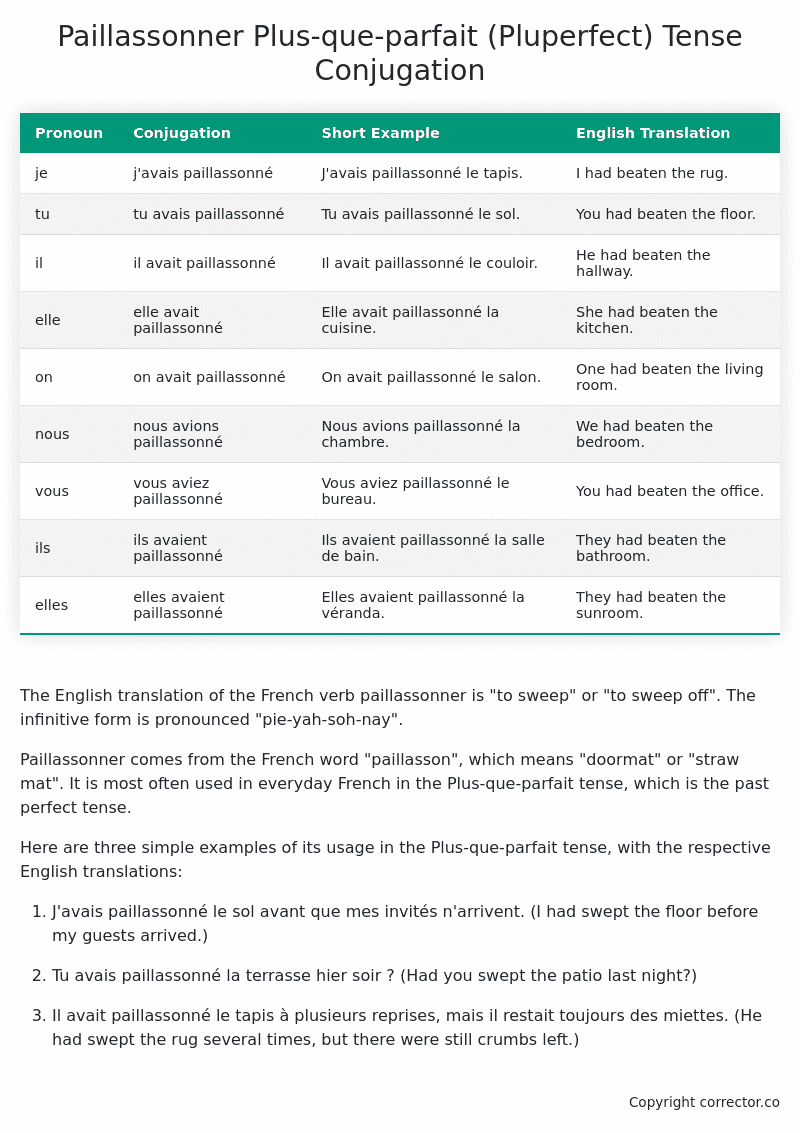Plus-que-parfait (Pluperfect) Tense Conjugation of the French Verb paillassonner
Introduction to the verb paillassonner
The English translation of the French verb paillassonner is “to sweep” or “to sweep off”. The infinitive form is pronounced “pie-yah-soh-nay”.
Paillassonner comes from the French word “paillasson”, which means “doormat” or “straw mat”. It is most often used in everyday French in the Plus-que-parfait tense, which is the past perfect tense.
Here are three simple examples of its usage in the Plus-que-parfait tense, with the respective English translations:
-
J’avais paillassonné le sol avant que mes invités n’arrivent. (I had swept the floor before my guests arrived.)
-
Tu avais paillassonné la terrasse hier soir ? (Had you swept the patio last night?)
-
Il avait paillassonné le tapis à plusieurs reprises, mais il restait toujours des miettes. (He had swept the rug several times, but there were still crumbs left.)
Table of the Plus-que-parfait (Pluperfect) Tense Conjugation of paillassonner
| Pronoun | Conjugation | Short Example | English Translation |
|---|---|---|---|
| je | j’avais paillassonné | J’avais paillassonné le tapis. | I had beaten the rug. |
| tu | tu avais paillassonné | Tu avais paillassonné le sol. | You had beaten the floor. |
| il | il avait paillassonné | Il avait paillassonné le couloir. | He had beaten the hallway. |
| elle | elle avait paillassonné | Elle avait paillassonné la cuisine. | She had beaten the kitchen. |
| on | on avait paillassonné | On avait paillassonné le salon. | One had beaten the living room. |
| nous | nous avions paillassonné | Nous avions paillassonné la chambre. | We had beaten the bedroom. |
| vous | vous aviez paillassonné | Vous aviez paillassonné le bureau. | You had beaten the office. |
| ils | ils avaient paillassonné | Ils avaient paillassonné la salle de bain. | They had beaten the bathroom. |
| elles | elles avaient paillassonné | Elles avaient paillassonné la véranda. | They had beaten the sunroom. |
Other Conjugations for Paillassonner.
Le Present (Present Tense) Conjugation of the French Verb paillassonner
Imparfait (Imperfect) Tense Conjugation of the French Verb paillassonner
Passé Simple (Simple Past) Tense Conjugation of the French Verb paillassonner
Passé Composé (Present Perfect) Tense Conjugation of the French Verb paillassonner
Futur Simple (Simple Future) Tense Conjugation of the French Verb paillassonner
Futur Proche (Near Future) Tense Conjugation of the French Verb paillassonner
Plus-que-parfait (Pluperfect) Tense Conjugation of the French Verb paillassonner (this article)
Passé Antérieur (Past Anterior) Tense Conjugation of the French Verb paillassonner
Futur Antérieur (Future Anterior) Tense Conjugation of the French Verb paillassonner
Subjonctif Présent (Subjunctive Present) Tense Conjugation of the French Verb paillassonner
Subjonctif Passé (Subjunctive Past) Tense Conjugation of the French Verb paillassonner
Subjonctif Imparfait (Subjunctive Imperfect) Tense Conjugation of the French Verb paillassonner
Conditionnel Présent (Conditional Present) Tense Conjugation of the French Verb paillassonner
Conditionnel Passé (Conditional Past) Tense Conjugation of the French Verb paillassonner
L’impératif Présent (Imperative Present) Tense Conjugation of the French Verb paillassonner
L’infinitif Présent (Infinitive Present) Tense Conjugation of the French Verb paillassonner
Struggling with French verbs or the language in general? Why not use our free French Grammar Checker – no registration required!
Get a FREE Download Study Sheet of this Conjugation 🔥
Simply right click the image below, click “save image” and get your free reference for the paillassonner Plus-que-parfait tense conjugation!

Paillassonner – About the French Plus-que-parfait (Pluperfect) Tense
Tense Formation
Common everyday usage patterns
Sequencing of past events
Background information
Hypothetical or reported speech
Interactions with other tenses
Summary
I hope you enjoyed this article on the verb paillassonner. Still in a learning mood? Check out another TOTALLY random French verb conjugation!


